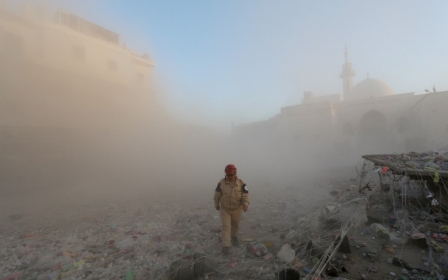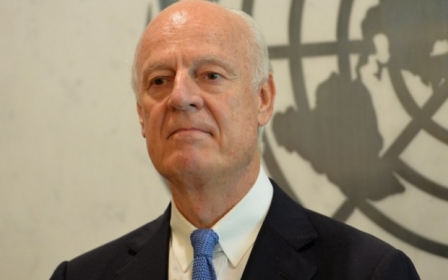The dynamics of the Syrian conflict, and how to resolve it

There is no real consensus on how to resolve the Syrian conflict, but there is one unifying belief regarding the urgent need to do so without delay. It has become an imperative in a desperate race against time to stop the fanatic jihadists in their tracks before they literally become an unstoppable global menace.
The divergence of opinions on how to best go about this, unfortunately, has less to do with pragmatism or the political and military realities of the conflict, and instead reflect the specific interests of those who hold them. While the world argues and procrastinates, a terrifying threat is slowly emerging from the chaos of Syria’s civil war: transnational jihadi terrorism. The premise is very simple, in order to end that threat, a workable resolution to its cause must be found.
What we are seeing now is the US - the most effective actor and power broker in the Middle East - pursuing a limited containment strategy against the most noxious of the jihadist groups -The Islamic State (IS) - in both Iraq and Syria. Its strategy in Iraq seems far more coherent than its Syrian counterpart, relying as it does, on the ground presence of trusted allies, namely the Iraqi army it built, and the Kurds to which it granted self-rule as Iraq fell apart after the 2003 invasion. The Syrian part is far more ambiguous and lacks clear vision.
In addition to almost daily sorties against IS, the US has now expanded the military campaign of its largely token coalition in Syria to target other Jihadist factions, such as Jabat al-Nusra and Ahrar al-Sham. The very same groups were considered indispensable allies by the local “moderate rebels,” who themselves were being backed against Assad’s forces by that coalition; but it seems that they now have been abandoned entirely.
In their stead, a new strategy - which seems to have very little chance at success - is being hastily formulated. The aim is to build a proxy rebel army from scratch to take on the Jihadists, recruiting from the sprawling refugee camps which house millions of displaced Syrians in neighbouring countries. It is unclear how the US will go about convincing Syrians brutalised and displaced by their regime to turn their attention away from battling it, and focus instead on fighting groups which they consider as brothers in arms.
The Americans either have to employ some extraordinary powers of persuasion, or otherwise end up with little more than a limited and mediocre mercenary force, motivated by money and lacking any real conviction in its cause. A force like that would stand little chance against the more numerous and better motivated fanatical jihadists, let alone a cornered regime viciously fighting tooth and nail for its very survival.
The regional allies of the US had meanwhile been pumping hundreds of millions of dollars-worth of weapons and financing into some very dubious Syrian rebel groups for the past three-and-a-half years. Much of which - we are now learning - has ended up in the hands of the very extremists that now pose such a grievous danger to regional stability and global security. This might have now finally convinced them to cut off funding and cease the covert facilitation that allowed thousands of foreign fighters - including well known battle hardened jihadists - to stream into Syria via Turkey by the busload. It has not yet convinced them however, to earnestly push for a comprehensive end to the conflict, which is now swiftly spinning out of control.
Instead, they seem stuck on the path they had obstinately pursued since the Syrian conflict first escalated from a popular mass uprising into a civil war. That path is to call for the toppling of the regime, and then support, arm and work to unite a plethora of groups with fundamentally conflicting ideologies and aims. This menagerie would include hard-line militant Islamists - arrayed against it, with little thought for the serious implications and consequences this ill-thought out strategy would have in future.
The US and many of its European allies merrily went along with this vague notion of regime change, failing to grasp the full implications of their commitment to toppling an entrenched and pervasive regime with a powerful army and the unflinching support of its allies.
For their part, the main backers of the Assad regime - Iran and Russia - believe it can ultimately triumph militarily, and eventually regain control of much of the territory it lost during three years of insurgency; in essence turning back the clock to pre-conflict dictatorship times when it had absolute and undisputed power. They too are motivated by their own narrow interests and not what’s best for Syria or its people. In Iran’s case, it is the sectarian-inspired struggle for influence over the Middle East with arch rivals, the Saudi-led Gulf. Russia meanwhile, is motivated by its own strategy to counter what it views as NATO expansion into its former spheres of influence.
This “eventual winner” view is fundamentally flawed, however, as the fabric of the complex multi-ethnic and multi-confessional Syrian society, it has now been profoundly and irreversibly torn apart by the polarisation of civil war. Any attempt to forcibly patch it back together again, without fundamentally changing the repression, corruption and brutality which lead to the mass explosion of popular anger in 2011, is doomed to fail. It may bring some sort of precarious stability in the short term, but this will likely not hold in the long run. The regime is unlikely to self-regulate and reform; it is simply structurally incapable of doing so and will collapse if it seriously tried to. Worse still, an outright regime victory might see it carry out pogroms of revenge against its opponents or campaigns of mass violence targeted at populations it views as having supported the rebellion.
But this view has been bolstered by shifting global perceptions toward the Syrian conflict, from a popular rebellion against tyranny, to a secular state under siege by the forces of extremism. Confusingly, both statements are currently equally valid. This has certainly played to the regime’s hand, and boosted perceptions of the likelihood of its survival, at least in the short term.
Ever opportunistic, it had previously taken advantage of the divisions and infighting that racked the opposing camp as well as the crippling impasse at the higher echelons of global policy making at the United Nations Security Council (UNSC). Now it is also using the US lead coalition’s strikes against the jihadists to its favour, pushing on full force with existing campaigns to recapture strategic territory it had lost long ago.
What we are left with is a rather grim assessment of the current situation in Syria, whereby an outright victory by either side is neither a real possibility nor a desirable prospect, while the jihadists - if left unchallenged - will grow to frightening proportions. Leaving the regime - at least in its current form - in power for the long term is also an unacceptable outcome for many, as is the proposed break up of Syria into sectarian cantons.
What is required to properly resolve the Syrian conflict is for the major powers backing both regime and opposition camps to fundamentally change their long held, self-centric policies and engage in meaningful talks which will see real concessions. The outcome would ideally be some form of transitional power sharing between those elements of the regime and opposition, acceptable to the majority of Syrians and capable of effectively addressing their grievances. This transitional authority would then be in a unique position to take on and eventually defeat extremism in Syria, with the help and support of the wider international community.
The time has now come for the world to get serious and committed to resolving the Syrian conflict; if not for the sake of the hapless Syrian people, then at least for the sake of global security and stability. In the meantime, pragmatism dictates they should be strongly pushing for a de-escalation and freezing of the conflict, creating conditions in which localised ceasefire can hold, and an environment both conductive to this peace process and hostile to those against it - namely the Jihadists and the profiteering warlords.
At the very least, if those peace talks fail, it would then be possible to cement a less desirable but just as equally viable scenario for the long term. A solution akin to the one that ended the long running civil war in neighbouring Lebanon: a de facto shotgun wedding and delicate balancing of diverging sectarian and political interests, in addition to possible self-rule but with no territorial break up.
- Edward Dark is MEE's Aleppo-based columnist and writes under a pseudonym
The views expressed in this article belong to the author and do not necessarily reflect the editorial policy of Middle East Eye.
Photo: People walk through debris in an area recently hit by an alleged air strike by Syrian government forces in the northern Syrian city of Aleppo on 11 November (AFP)
Middle East Eye propose une couverture et une analyse indépendantes et incomparables du Moyen-Orient, de l’Afrique du Nord et d’autres régions du monde. Pour en savoir plus sur la reprise de ce contenu et les frais qui s’appliquent, veuillez remplir ce formulaire [en anglais]. Pour en savoir plus sur MEE, cliquez ici [en anglais].





